

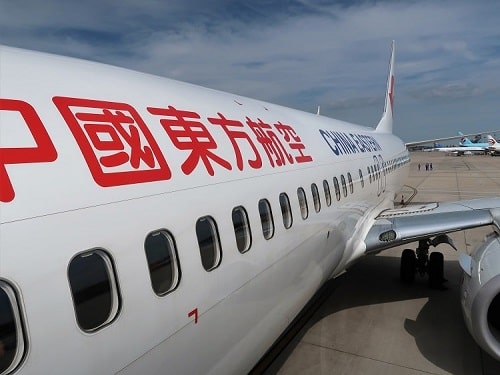
 BEST GUIDE TO CHINA
BEST GUIDE TO CHINA
Select Page
Visiting China soon? Start here
Guizhou
South China
3.5 million
Mandarin
This youthful, modern metropolis is unique among China’s big cities as it’s virtually hidden by the nature surrounding it. Guiyang’s skyscrapers and shopping malls are ringed by mountain ranges and some of China’s most pristine, dense highland forest.
Located in one of China’s poorer provinces, Guiyang is a mid-sized city with a population of over 3.5 million.But Guiyang is different from your average mid-sized Chinese city still entrenched in low-tech, polluting industries.
Doing away with much of its former heavy industry, Guiyang has made a conscious effort to fuel its economy via tech and big data. Guiyang is putting so much effort into becoming a city of the future that The Economist recently ranked Guiyang as China’s top emerging city.
But Guiyang is also a rare example of a Chinese city on the rise that’s yet to lose its provincial character. It’s more laid-back and slower paced than its big brothers.
Guiyang get tops marks in China for quality of life, relative lack of pollution and easy access to nature.
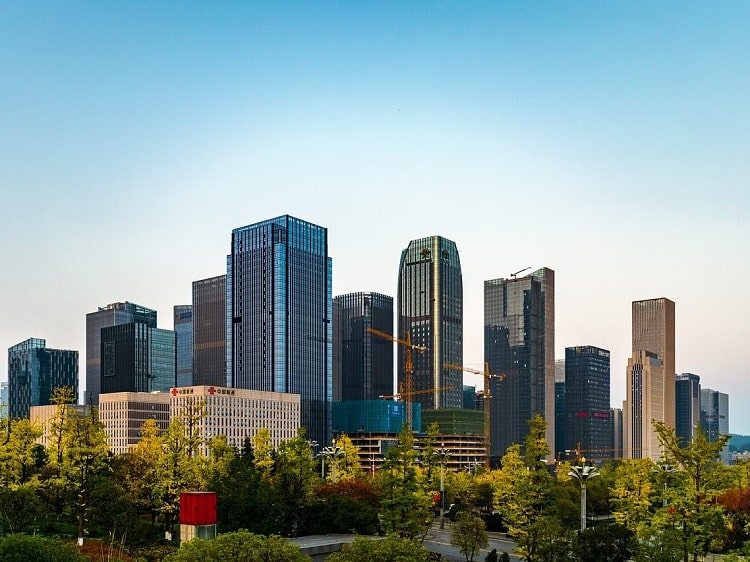
Guiyang is a modern city. Image by lin2015 on Pixabay.
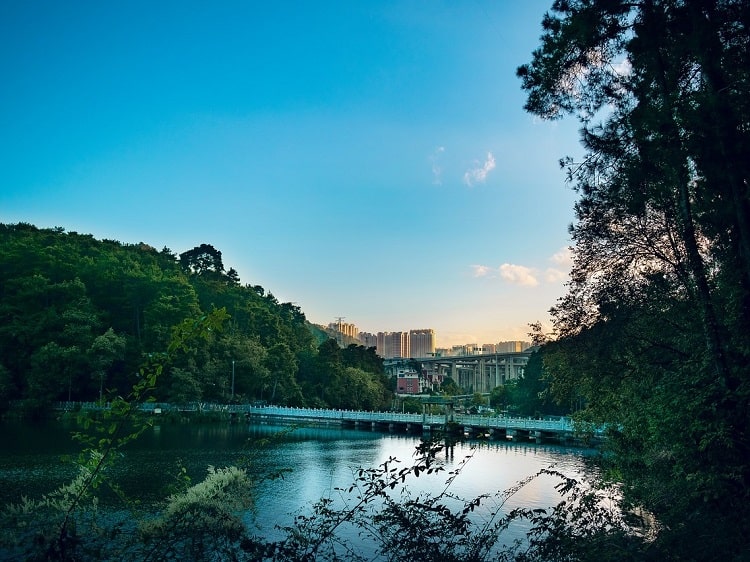
The green lungs of Guiyang. Image by lin2015 on Pixabay.
Guiyang has quickly become one of China’s leaders in cleaner, greener urban development.
Industrialization and deforestation has had a devastating impact on air quality in many Chinese cities.
But Guiyang prioritizes maintaining a clean environment, preserving vast green spaces and natural forest parks. This means the air is more breathable than in most Chinese cities.
Guiyang isn’t just surrounded by forest – the forest is part of the city itself. A massive urban green center, the incredible 1,000-acre Qianling Hill Park is 98% forest.
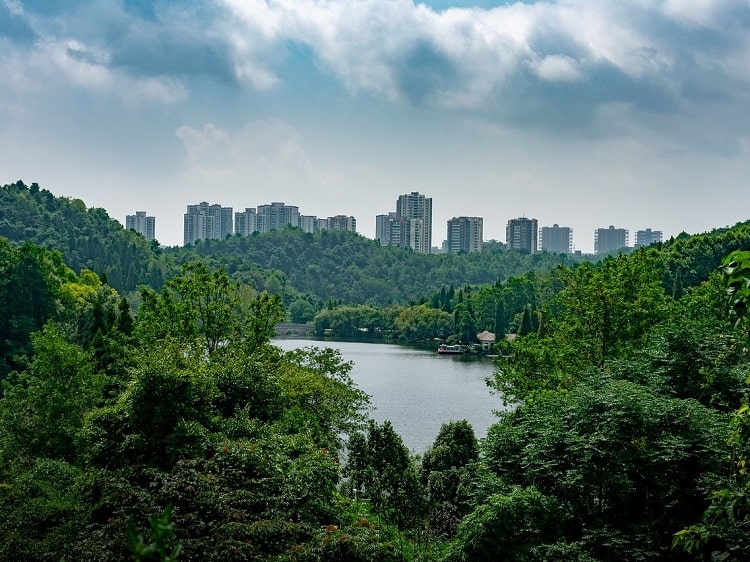
Guiyang is surrounded by lush, green trees.
Guizhou’s leaders, along with grassroots community movements, are actively working to increase forest coverage in the province. Now, forest covers almost 60% of Guizhou.
When you consider China’s generally poor environmental management record, what Guizhou has achieved (as one of the poorest provinces in the country) is extraordinary.
Guizhou is home to one of the largest rural-dwelling populations in the country.
Over 40 non-Han Chinese minority groups, including the Miao, Yao, Dong, Zhuang, Bouyei and Bai, account for more than 37% of Guizhou’s total population.
This ethnic mix make the city so interesting, especially from an outsider’s perspective. (Read more about what makes China so interesting.)
Many of the younger generation from the Miao and Dong ethnic groups have moved to Guiyang to improve their education and employment prospects.
However, a large number of ethnic communities have chosen to stay in their rural hometowns.
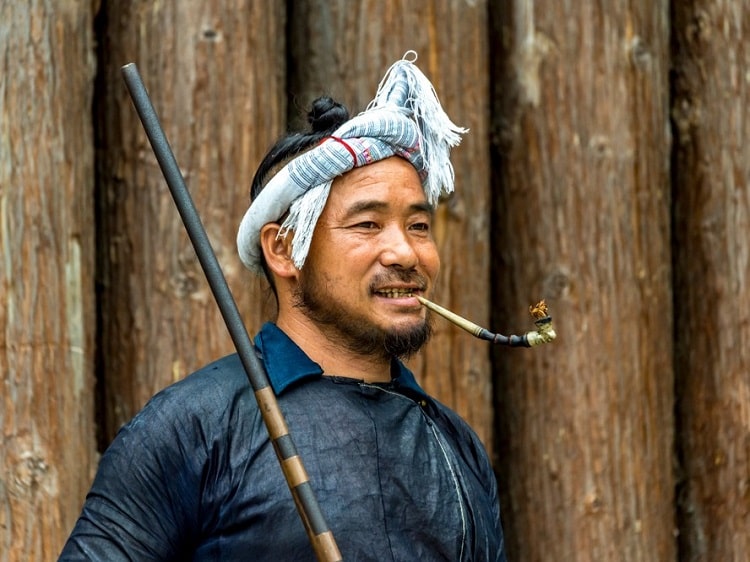
A Miao man in Guizhou. Image by Jixin Yu on Shutterstock.
Here, they still live a largely traditional, mainly agricultural way of life. Difficulty of access caused by Guizhou’s mountainous terrain has meant basic infrastructure, and consequently tourism and its influences, have been extremely slow to arrive.
By contrast to rural Guizhou, Guiyang is a young, energetic and surprisingly developed city – a modern, urban Chinese center with visions of a prosperous future.
Guiyang’s main attractions revolve around its natural beauty.
Remarkably well preserved, this fascinating old town from the Qing and Ming Dynasties was founded in 1378. It lies in the southern suburbs of Guiyang, about a 15-minute taxi ride from downtown.
Houses, temples and monasteries are built almost entirely out of the local blue-tinged cyan stone.
The town also boasts atmospheric wide streets, exquisitely carved landmarks and hundreds of relic sites scattered across the easily walkable grounds.
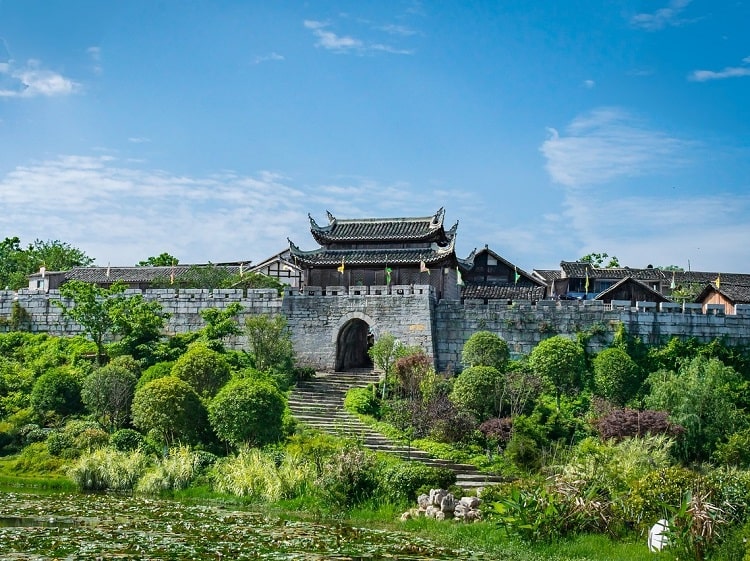
Qingyan Ancient Town is popular with tourists. Image by lin2015 on Pixabay.
Qingyan Ancient Town is unique in that several religious communities lived together in peace during various periods of its history.
You’ll find Buddhist temples, Taoist shrines and Christian churches sitting side-by-side.
Just a mile from downtown Guiyang is one of southern China’s biggest and most beautiful urban nature parks – Qianling Park.
Spread over 1,000 acres (426 hectares) and surrounded by forested mountains, this park really is the green lungs of the city.
A cable car ride takes you to the highest point the in park, Qianling Hill. At the top stands the Zen Buddhist Hongfu Temple, built in 1667.
Qianling is a haven for hikers, bird life and also the park’s famous resident macaques.
Yes, this is one of the best places to see wild monkeys in China!

A hungry macaque monkey in Qianling Park. Image by YKLiu on Shutterstock.
Extremely bold, the monkeys seem to be constantly scheming new ways to snatch food, bags and hats from unsuspecting tourists.
Please though, be a responsible tourist and don’t feed them. This only encourages aggressive behavior.
At the foot of the hill, picturesque Qianling Lake is another highlight. With numerous hiking trails and hidden shrines, it’s easy to find your own tranquil spot far from the crowds.
This is almost impossible to find in most Chinese cities!
With shiny new towers springing up all over town, Guiyang isn’t exactly overflowing with historic architecture.
The 65-foot (20 m) high Jiaxiu Tower is an exception. Atop the Fuyu Bridge, the three-story pavilion (which has gone through several part-reconstructions) dates back 400 years to the Ming Dynasty.
From the top, a clear day will treat you to a panoramic view of the city and the mountain ranges beyond. The pavilion is lit up at night to cast its reflection on the waters of the Nanming River below.
Guiyang is surrounded by incredible mountain landscapes, rivers and waterfalls.
Among the most stunning is Tianhe Pool, 15 miles (24 km) from downtown. The pool itself is a sparkling lake surrounded by a patchwork of karst hills and steep valleys, caves and waterfalls.
Tianhe is normally quite peaceful but does attract group day tours and weekend crowds from time to time. It’s best appreciated early in the morning when you may well have this sanctuary all to yourself.
Like most people in southwest China, Guiyang locals love spicy food.
Don’t be surprised to come across dishes smothered in dried chilies, especially the local hotpot (贵州火锅).
If you can’t handle too much heat, and you hear the word là, be sure to tell your waiter: bù tài là (不太辣) before you order!
A few local specialties include:
These chewy soup noodles, from Guiyang’s Huaxi district, are pure Chinese soul food.
The dish is made from a stock of beef, pork, chicken bones, and spices which simmer for almost 12 hours. This gives the soup a deep and rich, beefy flavor.

A bowl of Huaxi beef rice noodles. Image by HelloRF Zcool on Shutterstock.
It’s usually topped with chili oil and herbs to give it a bit of a kick.
This classic Miao fish stew is a staple across Guizhou. It’s made with tomatoes, pickled chili, cabbage and fish collected from the rice paddy terraces.
It’s brought to the table still bubbling away in an impressive metal burner. This soup is tangy, fragrant, bursting with flavor – delicious!
Similar to Vietnamese rice paper rolls, this vegetarian dish in China is usually served DIY style.
You’ll be given a stack of think rice pancakes (silk babies, pronounced ‘siwawa’) and a variety of raw and pickled vegetables.
Grab a pancake and fill it with whatever takes your fancy. Then roll it up, dunk in chili and vinegar, and enjoy!
Wandering around downtown Guiyang you’ll find plenty of places to eat at reasonable prices.
There are also street food and fresh fruit vendors on virtually every corner.
Finding traditional Guizhou and Miao food isn’t difficult. However, it’s a good idea to start your flavor crusade with one of the most well-known purveyors of excellent, authentic Guizhou cuisine, Siheyyan.
This place is so popular that it’s overtaken several of the surrounding alleyways to squeeze in as many tables as possible. You’ll find it opposite the large Protestant Church with the red cross on Qianling Lu.
Address: 79 West Qianling Road Road, Yunyan District (云岩区干陵西路79)
Another Guiyang institution (you can guess what the specialty is here), this restaurant has several branches. The Shengfu Road branch is particularly popular and arguably the most tourist-friendly option. The atmosphere is buzzing and the fish soup is top-notch.
Address: 55 Shengfu Road, Yunyan District (云岩区省府路55号)
Bean hotpot is an authentic Guiyang hotpot with a broth of kidney bean seeds, Chinese sauerkraut, cured meat, pork fat, pickled pepper, garlic shoots and green onions.
Unlike most hotpots, this version isn’t doused with chili. It’s safe for the spice phobic! The flavor is unique, balanced and incredibly tasty.
This famous restaurant has a rustic storefront and timber furniture, giving off a charming village-like vibe in a busy part of town.
Address: 35 Qianling East Road, Yunyan District (云岩区黔灵东路35号)
Night markets are hugely popular in Guiyang.
If the city center seems a little empty in the evening, it’s probably because the student and worker hordes have dispersed into suburbia to feast at their favorite night markets.
A typical night market includes innumerable grilled-meat-on-stick stalls, dumplings, all sorts of noodle concoctions, stir fries, mini hotpots and all kinds of unusual delicacies from Guizhou’s ethnic communities.
Night markets are spread across the city, usually in suburban areas. From downtown, hop in a taxi and try some of these popular evening haunts:
An ordinary street by day lit up by a kaleidoscope of bright lights by night, Hequn Road is one of the biggest and busiest night markets in Guiyang. Located close to Qianling Park, some stalls stay open until 3 am!
You’ll find all the famous street snacks from Guizhou like Huaxi beef noodles and candied hawthorn berries, as well as more unusual specialties such as snake meat.
The buzzing, youthful atmosphere makes Hequan a great place to spend a night out.
Smaller and slightly more low-key than Hequan, Xingguan stil offers plenty of variety. Favorites from Guizhou and around southeastern China are represented here.
The market is known for its quality selection of grilled meats and seafood, like freshwater fish, crayfish and field snails, all at cheap prices.
There are some good accommodation options in Guiyang, ranging from cheap hostels to pricey hotels.
Still catering more towards business than tourism, the super low-priced hotels found in other Chinese cities are rare in Guiyang.
A few hostels are beginning to pop up however, including February of That Year Hostel. It’s a good-value offering, with colorful, well-equipped, air-conditioned private rooms and dorms, and a friendly young team of staff.
The only problem is it’s located in the Hua Guo Yuan District, which is a long walk from the center of town.
While there are some restaurants and shops in the immediate vicinity, you might prefer to use the shuttle bus that ferries guests to and from the downtown area.
The Howard Johnson Plaza was once one of the plushest digs in town.
Now looking slightly old-fashioned, it’s easily one of the best bargains in Guiyang. The rooms are huge and spotless and the service is kind and obliging.
It’s a quick taxi ride to the center of town, and only a short walk to Qianling Park. So, if you want to experience the atmosphere of the park in the early morning, this hotel makes a good choice.
The Sofitel Guiyang Hunter has a plush mix of rooms and executive suites, many with dramatic mountain views.
Unlike a lot of other upscale hotels, it’s also reasonably close to downtown and the Yunyan restaurant district. It has pretty much everything you’d expect – a pool, a day spa, and a 55th floor cocktail lounge with superb city views.
It also boasts the upmarket Le Chinois Restaurant, which specializes in Sichuan and Cantonese cuisine.
You’ll most likely arrive in Guiyang from elsewhere in China, either by air, rail or the slow, scenic option – by road.
Thanks to the new high-speed rail network, Guiyang is well-connected to other towns and cities.
The compact Guiyang International Airport connects Guiyang to major cities like Beijing, Shanghai and Hangzhou.
You can fly with a number of domestic Chinese airlines including the local carrier, Colorful Guizhou Airlines.
International flights to Guiyang are growing little by little. In 2014, Hainan Airlines kicked off weekly flights to Paris. There are daily flights to and from Hong Kong (two hours).
Long distance buses are still the only way to reach destinations in the more remote southwestern parts of Guizhou, such as Weining and Cao Hai Lake.
If you’re on a budget, they’re also extremely cheap. Long distance coaches are surprisingly convenient and comfortable, and the much-improved expressway network in this region has made road travel more accessible than ever.
For getting around town, taxis remain super convenient. Almost 8,000 taxis operate in the city.
Guiyang is also building a fleet of eco-friendly taxis, now numbering around 200.
Hailing a cab on the street is easy and fares are cheap. Just be aware of traffic jams during peak times.
You can also download DiDi on your phone. This is China’s version of Uber.
Find out more about Didi and other helpful travel apps for China here.
For short-distance travel to tourist hot spots like Tianhe Scenic Area, public buses are inexpensive, if a little confusing at first. You can always write down where you want to go and ask a friendly local for help.
For example, to get to Tianhe from downtown, look for the 211 bus which leaves from Binhe Park.
This takes visitors to other major locations in Guizhou such as the famous Huangguoshu Waterfall (2 hours, departing every 45 minutes) and Anshun City (60-90 minutes, departing every 20-30 minutes).
Guiyang’s biggest drawcard isn’t the town itself.
Rather, it’s the extraordinary natural beauty and enchanting rural villages surrounding it.
Some of the (admittedly more developed towns) are just half a day’s drive away, but still seem worlds away from the bright lights of the city.
‘Ethnic minority tourism’ is hardly a new thing in China. In fact, some ethnic villages in the neighboring province of Guangxi have been transformed into gaudily reconstructed tourist towns, complete with fake building facades and karaoke bars.
But if you have any interest in the diverse cultures of southern China’s ethnic minorities, Guizhou offers an authentic and immersive cultural experience.
Just be aware that public transport can be infrequent where the train lines end. Travel is slow and reaching some of Guizhou’s remote villages may require the services of a private driver to guide you safely through the windy mountain roads.
If you want to visit the ethnic minority villages, Guiyang is a great place to begin your journey.
Unlike Guangxi province to the south, where many villages have been developed to cater for tourism, Guizhou province sees far fewer visitors. Many of the Miao, Dong, Shiu and Bouyei communities here have retained a traditional way of life.
Guided tours are available from Guiyang with advanced bookings, although the adventurous can visit many of the villages by a combination of public buses and short hikes through some absolutely breathtaking scenery.
Some of the larger villages have guesthouses available for overnight stays. Just remember to be mindful of the local culture and customs and you’ll find the vast majority of the locals to be warm, friendly and curious towards visitors.
If you visit in the late summer, you might be lucky enough to witness the annual buffalo fighting festival held throughout several Dong villages.
Each minority group celebrates dozens of religious and folk festivals throughout the year. Full of elaborate traditional costumes, song, dance and ritual, it’s well worth timing your visit to coincide with a major festival.
Get a visual taste of Guiyang before you visit!
Here’s a quirky video of just how nice and modern Guiyang is.
And here’s another helpful video showing how cheap Guiyang can be.
Going on a tour in China is a great idea, especially if you can’t speak Mandarin.
You can refer to this list of China travel agencies who can help put a plan together for you.
Or, to book your own flights, tours and hotels, we recommend Trip for amazing choice and value. Trip is one of the leading travel companies in China.
It’s easy to forget a thing or two before you head to China.
So, here are a few reminders for you:
Have a great time in Guiyang. And remember to get your VPN!
Then hop on the newsletter!
Let’s chat about Guiyang!
We welcome relevant and respectful dialogue. See our terms for our comment policy.
Page last updated 1 November 2022. Main image credit: Lin2015 from Pixabay. Commercial relationship disclosure: The Helpful Panda has commercial arrangements with organizations that may appear on this page, such as affiliate links. See our terms for more info.
Do you want to build your career in China?
VIEW JOBS



Our writers have all experienced China in person. Support them by subscribing to the free monthly newsletter about visiting China.